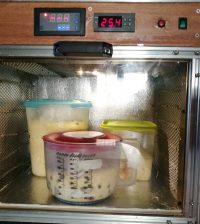- makeITcircular 2024 content launched – Part of Maker Faire Rome 2024Posted 2 weeks ago
- Application For Maker Faire Rome 2024: Deadline June 20thPosted 2 months ago
- Building a 3D Digital Clock with ArduinoPosted 7 months ago
- Creating a controller for Minecraft with realistic body movements using ArduinoPosted 7 months ago
- Snowflake with ArduinoPosted 8 months ago
- Holographic Christmas TreePosted 8 months ago
- Segstick: Build Your Own Self-Balancing Vehicle in Just 2 Days with ArduinoPosted 8 months ago
- ZSWatch: An Open-Source Smartwatch Project Based on the Zephyr Operating SystemPosted 9 months ago
- What is IoT and which devices to usePosted 9 months ago
- Maker Faire Rome Unveils Thrilling “Padel Smash Future” Pavilion for Sports EnthusiastsPosted 10 months ago
2016 Hackaday Prize: $300,000 cash prizes, 5 challenges. Submit your idea, change the World!
The Hackaday Prize is a competition synonymous with creating for social change. Using your hardware, coding, scientific, design and mechanical abilities, you will make big changes in peoples’ lives.
Last year we wrote about Hackaday Prize 2015 and about its winner, EYEDRIVEOMATIC.
This year, Hackaday did an awesome thing: they splitted the competition in 5 categories, made in series, to select 100 ideas for the final round.
How it works:
We’re starting off with an Idea Slam, where you can submit a Design Concept. Then we give you 4 more Hackaday Prize challenges to run with; choose to enter any or all Challenges.
These 5 challenges run in series (one after the other) and each challenge lasts just 5 weeks. Big things start with just an idea, and if you want them to, concept drawings can bring in collaborators.
20 projects will be chosen from each of the 5 rounds, and awarded $1000 per project.
At the end of all 5 rounds, 100 projects in total will advance to the finals where 5 top prizes will be awarded: $150k, $25k, $10k, $10k and $5k. In addition the 1st place project will win a residency in the Supplyframe Design lab to develop their project further.
Challenges:
Design your concept
Starts March 14th – Ends April 25th
We want to see your ideas in words and pictures. The Design Concept is the idea, it’s how you think about your project, it’s how you go about planning to solve the question you want to solve. It’s how you use your logic and creativity to move your design forward.
Minimum entry requirements:
Idea + image + documentation
- Project Profile. Create a project profile on Hackaday.io, completing all required fields and following all instructions. Submit the Project to 2016 Hackaday Prize.
On the Project Profile:
- Discuss the challenge which has been chosen as the subject of the project
- Discuss how this challenge will work to alleviate or solve the problem
- Publish at least one image to help illustrate how the project might be used. This may be a sketch, schematic, flow chart, rendering, or other type of image.
- Link to any repositories (e.g., GitHub)
- Document all open-source licenses and permissions as well as any applicable third-party licenses/restrictions
Anything goes
Starts April 25th – Ends May 30th
You are a nonconformist, a misfit. You’re an independent thinker, a troublemaker, and have no respect for the status quo. Build whatever you want.
Minimum entry requirements:
Idea + image + documentation + 4 build logs
- Project Profile. Create a project profile on Hackaday.io, completing all required fields and following all instructions. Submit the Project to 2016 Hackaday Prize.
On the Project Profile:
- Discuss the challenge which has been chosen as the subject of the project
- Discuss how this challenge will work to alleviate or solve the problem
- Publish at least one image to help illustrate how the project might be used. This may be a sketch, schematic, flow chart, rendering, or other type of image.
- Show at least four Project Log updates
- Link to any repositories (e.g., GitHub)
- Document all open-source licenses and permissions as well as any applicable third-party licenses/restrictions
Citizen scientist
Starts May 30th – Ends July 11th
This challenge is about expanding the frontiers of knowledge. Create something new, study something undiscovered, or replicate and verify scientific studies. Need an example? Build a graphene supercapacitor, study the effects of a behavior, build an open source instrumentation device.
Minimum entry requirements:
Idea + image + documentation + 4 build logs
- Project Profile. Create a project profile on Hackaday.io, completing all required fields and following all instructions. Submit the Project to 2016 Hackaday Prize.
On the Project Profile:
- Discuss the challenge which has been chosen as the subject of the project
- Discuss how this challenge will work to alleviate or solve the problem
- Publish at least one image to help illustrate how the project might be used. This may be a sketch, schematic, flow chart, rendering, or other type of image.
- Show at least four Project Log updates
- Link to any repositories (e.g., GitHub)
- Document all open-source licenses and permissions as well as any applicable third-party licenses/restrictions
Automation
Starts July 11th – Ends August 22nd
Automate your life. Program a robot to obey your every command. Build a device that makes breakfast or buys laundry detergent when you’re running low. Automatically track stuff, automate any process, build a Me-robot to do your every whim..
Minimum entry requirements:
Idea + image + documentation + 4 build logs
- Project Profile. Create a project profile on Hackaday.io, completing all required fields and following all instructions. Submit the Project to 2016 Hackaday Prize.
On the Project Profile:
- Discuss the challenge which has been chosen as the subject of the project
- Discuss how this challenge will work to alleviate or solve the problem
- Publish at least one image to help illustrate how the project might be used. This may be a sketch, schematic, flow chart, rendering, or other type of image.
- Show at least four Project Log updates
- Link to any repositories (e.g., GitHub)
- Document all open-source licenses and permissions as well as any applicable third-party licenses/restrictions
Assistive technologies
Starts August 22th – Ends October 3rd
Build a project that helps others move better, see better, or live better. Whether that means exoskeletons, a better wheelchair, a braille display, or educational software, we want to see it.
Minimum entry requirements:
Idea + image + documentation + 4 build logs
- Project Profile. Create a project profile on Hackaday.io, completing all required fields and following all instructions. Submit the Project to 2016 Hackaday Prize.
On the Project Profile:
- Discuss the challenge which has been chosen as the subject of the project
- Discuss how this challenge will work to alleviate or solve the problem
- Publish at least one image to help illustrate how the project might be used. This may be a sketch, schematic, flow chart, rendering, or other type of image.
- Show at least four Project Log updates
- Link to any repositories (e.g., GitHub)
- Document all open-source licenses and permissions as well as any applicable third-party licenses/restrictions
Check the rules and other suggestions on the official 2016 Hackaday Prize website
















